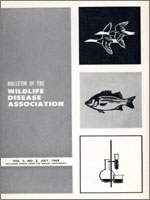Studies show that duck plague virus elicits comparable clinical and pathologic responses in domestic White Pekin ducks (Anas platyrhynchos domesticus), wild mallard ducks (Anas platyrhynchos), and Canada geese (Branta canadensis). All these birds were infected by oral inoculation or contact exposure. The antibody response was similar in both duck species. Clinical signs were ruffled feathers, increased lachrymation, nasal secretion, diarrhea, and reddening of the cloacal mucosae. The mortality rate was high in Pekin ducks and Canada geese, while mallard ducks were more resistant. Serums from birds that survived infection had a relatively high antibody level. The pathologic changes were qualitatively comparable in all three waterfowl species and were characterized by generalized congestion, hemorrhages in the serous and mucous membranes and necrosis of the gastrointestinal mucosae as well as the liver. Intranuclear inclusion bodies having staining characteristics of DNA viruses were found in the hepatic cells and epithelium of the esophageal and cloacal mucosae. These inclusions and other pathologic alterations might be valuable in diagnosing duck plague in wild waterfowl.
BioOne.org will be down briefly for maintenance on 17 December 2024 between 18:00-22:00 Pacific Time US. We apologize for any inconvenience.
How to translate text using browser tools
1 July 1969
RESPONSE OF PEKIN AND MALLARD DUCKS AND CANADA GEESE TO EXPERIMENTAL INFECTION WITH DUCK PLAGUE VIRUS
A. H. DARDIRI,
P. GAILIUNAS





